|
|
|
Sort Order |
|
|
|
Items / Page
|
|
|
|
|
|
|
| Srl | Item |
| 1 |
ID:
090415


|
|
|
|
|
| Publication |
2008.
|
| Summary/Abstract |
This paper reviews the history of the use of anti-personnel (AP) landmines, the run-up to the adoption of a treaty banning their use, and issues related to the military utility and the humanitarian cost of the weapon. Finally it also develops some of the discussions related to alternatives to the use of AP landmines.
|
|
|
|
|
|
|
|
|
|
|
|
|
|
|
|
| 2 |
ID:
090406
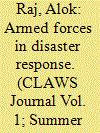

|
|
|
|
|
| Publication |
2008.
|
| Summary/Abstract |
The Indian armed forces have rendered disaster aid to a number of countries in the past, adding yet another dimention to the international disaster response. A number of countries look up to India on many a front, especially when struck by a major calamity. With growing regional and global cooperation in disaster reduction and response, the Indian armed forces can play a vital role befitting India's emerging status of regional power.
|
|
|
|
|
|
|
|
|
|
|
|
|
|
|
|
| 3 |
ID:
090372
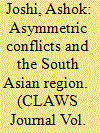

|
|
|
|
|
| Publication |
2008.
|
| Summary/Abstract |
The South Asian region is of considerable strategic importance for the entire world. An example of the foregoing is the fact that various sea lanes of communication and trading routes from West Asia to the Far East pass through this region. Again, of the seven nations in South Asia, two are nuclear states. Yet, strange as it may seem, some South Asian nations, while grappling with insurgency, terrorism, fundamentalism, illegal migration, poverty and organised crime, plan conflicts with their neighbours similarly affected.
|
|
|
|
|
|
|
|
|
|
|
|
|
|
|
|
| 4 |
ID:
090400
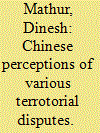

|
|
|
|
|
| Publication |
2008.
|
| Summary/Abstract |
China has common land frontiers with North Korea, Russia, Kazakhistan, Khirgizistan, Tadzikistan, Mongolia, afghanistan, Pakistan, India, Nepal, Bhutan, Myanmar, Vietnam and Laos. Small wonder that the communists, on coming to power in 1949, recorded 119 border problems with the neighbours. Against India, what was essentially a semi-ratified Indo-Tibetan border problem, became a full-fledged Sino-Indian border dispute.
|
|
|
|
|
|
|
|
|
|
|
|
|
|
|
|
| 5 |
ID:
090396
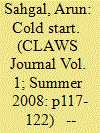

|
|
|
|
|
| Publication |
2008.
|
| Summary/Abstract |
Notwithstanding the above concerns, there can be no doubt that the cold start doctrine is a viable response to Pakistan's proxy war strategy of bleeding India. It represents a significant advance in India's conventional capabilities. Analyses of the recent exercises indicate that the requisite organisational and conceptual changes are being effected to make the doctrine a viable response option.
|
|
|
|
|
|
|
|
|
|
|
|
|
|
|
|
| 6 |
ID:
090376
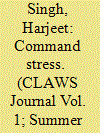

|
|
|
|
|
| Publication |
2008.
|
| Summary/Abstract |
The purpose of this article is to document the enormous variety of stressors that the modern commander might face. This Taxonomy should be useful for commanders to identify which types of stressor they are experiencing and which types they personally find difficult to manage. If they can do this, they are closer to knowing where they should focus their attention when trying to predict thein own stress reactions. It is then possibel to train to control both the stressor and one's reaction to it.
|
|
|
|
|
|
|
|
|
|
|
|
|
|
|
|
| 7 |
ID:
090411
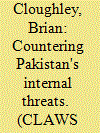

|
|
|
|
|
| Publication |
2008.
|
| Summary/Abstract |
There are two main types of internal violence occupying the attention of the army in Pakistan: the comparative new but ever-present threat of suicide bombings, many specially directed against military personnel and bases; and ongoing conflict in the Northwest Frontier Province (NWFP) and Balochistan. Both are major challenges and the latter requires extensive specialist training, while achieving balance in force structure and capabilities is proving time-consuming and expensive.
|
|
|
|
|
|
|
|
|
|
|
|
|
|
|
|
| 8 |
ID:
090403
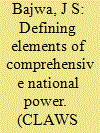

|
|
|
|
|
| Publication |
2008.
|
| Summary/Abstract |
Economic globalization has not only been accelerationg the process of integration of the world economy but also competition among/between countries, especially that among big powers. International competition manifests itself mainly in the dynamic changes in the strategic resources of different countries and the open competition in the Comprehensive national power. Comprehensive national power (CNP)is a concept that is based on the contemporary political thought of the People's Republic of China and refers to the general power of a nation-state.
|
|
|
|
|
|
|
|
|
|
|
|
|
|
|
|
| 9 |
ID:
090408
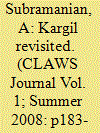

|
|
|
|
|
| Publication |
2008.
|
| Summary/Abstract |
The Kargil conflict treads a very thin line between limited and subconventional conflict because of the manner in which the infiltration was conducted by regulars of the Pakistan Northern Light Infantry (NLI) supported by sprinkling of jehadis, Mujahideen and foreign terrorists, and the diverse manner in which the Indian Army and Indian Air Force reacted to the intrusion.
|
|
|
|
|
|
|
|
|
|
|
|
|
|
|
|
| 10 |
ID:
090383
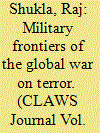

|
|
|
|
|
| Publication |
2008.
|
| Summary/Abstract |
The motivation for unleading the GWOT was obviously 9/11. The military campaign to demolish the Al Qaeda and its Taliban sponsors in Afghanistan, thereafter, was perhaps justified. Widening the swathe of the military onslaught to Iraq, however, was clearly a mistake, especially now that it is abundantly clear that the conflict there had more to do with settling scores with an old foe than with any terror links with 9/11 or weapons of mass destruction (WMD).
|
|
|
|
|
|
|
|
|
|
|
|
|
|
|
|
| 11 |
ID:
090397


|
|
|
|
|
| Publication |
2009.
|
| Summary/Abstract |
Post 9/11, President Bush had been exploring options for retaliation against Iraq and by the middle of December 2001, he had made up his mind to overthrow Saddam Hussein in the next phase of the US war on terrorism. After the destruction of the al Qaeda network in Afghanistan, speculation was rife that Bush would now go after Saddam Hussein.
|
|
|
|
|
|
|
|
|
|
|
|
|
|
|
|
| 12 |
ID:
090413


|
|
|
|
|
| Publication |
2008.
|
| Summary/Abstract |
The most recent international disarmament capaign has resulted from a series of developments: the September 11, 2001 attacks; the unveiling of the AQ Khan proliferation network; North Korea's 2006 nuclear test; Pakistan's political instability; and Iran Uranium enrichment programme. Worrying that the number and spread of nuclear weapons may soon get out of hand as a result of these and other developments, many individuals and institutions are making renewed calls for disarmamement efforts with the aim of completely eliminating nuclear weapons.
|
|
|
|
|
|
|
|
|
|
|
|
|
|
|
|
| 13 |
ID:
090412


|
|
|
|
|
| Publication |
2008.
|
| Summary/Abstract |
Tibet is again in unrest, and the news- a reflection of the long simmering resentment against the Chinese rule which has erupted once more. This time, the unrest is unique in many ways; its timing threatens to mar the Beijing Olympics, the beggest international event to be hosted by the China, signifying its acceptance by the international community.
|
|
|
|
|
|
|
|
|
|
|
|
|
|
|
|
| 14 |
ID:
090414
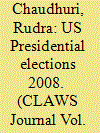

|
|
|
|
|
| Publication |
2008.
|
| Summary/Abstract |
For almost a year, the debate on the N deal has made clear the polarised, and sometimes wavering, positions held by the three most significant sub-cultures of India's national body-politik. These include the left, who oppose the operationalisation of 123 agreement; Bhartiya Janta Party (BJP), which, according to party head L K Advani, will consider supporting the Congress only if certain laws are amended to prevent the Hyde Act from applying to India.
|
|
|
|
|
|
|
|
|
|
|
|
|
|
|
|
| 15 |
ID:
090386
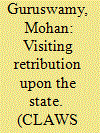

|
|
|
|
|
| Publication |
2008.
|
| Summary/Abstract |
The current discourse on human rights is generally circumscribed by the December 10, 1948, Universal Declaration of Human Rights proclaimed by the UN General Assembly. A close scrutiny of this declaration will reveal endowing an individual anywhere in the world with certain rights considered to be self-evident and inalienable, except for article 25 and 26, there is little suggestion of the responsibilities of states to provide the individual the minimum means of sustenance, basic education and health care, and the means to have a worthwhile standard of living.
|
|
|
|
|
|
|
|
|
|
|
|
|
|
|
|
|
|
|
|
|